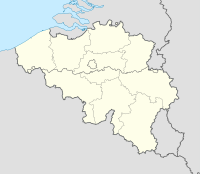Siege of Namur (1914)
| Siege of Namur | |||||||
|---|---|---|---|---|---|---|---|
| Part of the Western Front of World War I | |||||||
 Map of the city and Fortified Position of Namur |
|||||||
|
|||||||
| Belligerents | |||||||
|
|
|
||||||
| Commanders and leaders | |||||||
|
|
|
||||||
| Strength | |||||||
| 107,000 | 35,000 | ||||||
| Casualties and losses | |||||||
| 300 killed, 600 wounded or missing |
c. 15,000 (including 6,700 taken prisoner) |
||||||
|
Namur in the Arrondissement of Namur, Belgium
|
|||||||
The Siege of Namur (French: Siège de Namur) was a battle between Belgian and German forces around the fortified city of Namur during World War I. Namur was defended by a ring of modern fortresses, known as the Fortified Position of Namur and guarded by the Belgian 4th Division. When the siege began on 20 August, the German forces used experience gained at the Battle of Liège (4–16 August) and bombarded the forts using German super-heavy siege artillery and four batteries on loan from Austria-Hungary, before attacking with infantry.
The French army was defeated at the Battle of Charleroi and managed to pass only one regiment into Namur as a reinforcement. The forts were destroyed by the bombardment, some being demolished by conventional heavy artillery rather than the siege guns, due to flaws in the concrete protection encasing the forts. The last of the Belgian fortress troops were forced to surrender on 25 August, after the survivors of the Belgian 4th Division had withdrawn to the south through the French Fifth Army and eventually joined the Belgian field army at Antwerp during the siege.
Belgian military planning was based on an assumption that other powers would eject an invader but the likelihood of a German invasion, did not lead to France and Britain being seen as allies or for the Belgian government intending to do more than protect its independence. The Anglo-French Entente (1904) had led the Belgians to perceive that the British attitude to Belgium had changed and that it was seen as a British protectorate. A General Staff was formed in 1910 but the Chef d'État-Major Général de l'Armée, Lieutenant-Général Harry Jungbluth was retired on 30 June 1912 and not replaced until May 1914 by Lieutenant-General Chevalier de Selliers de Moranville who began planning for the concentration of the army and met railway officials on 29 July. Belgian troops were to be massed in central Belgium, in front of the National redoubt of Belgium ready to face any border, while the Fortified Position of Liège and Fortified Position of Namur were left to secure the frontiers. On mobilization, the King became Commander-in-Chief and chose where the army was to concentrate. Amid the disruption of the new rearmament plan, the disorganised and poorly trained Belgian soldiers would benefit from a central position, to delay contact with an invader but it would also need fortifications for defence, which were on the frontier. A school of thought wanted a return to a frontier deployment in line with French theories of the offensive. Belgian plans became a compromise in which the field army concentrated behind the Gete river with two divisions forward at Liège and Namur.
...
Wikipedia

